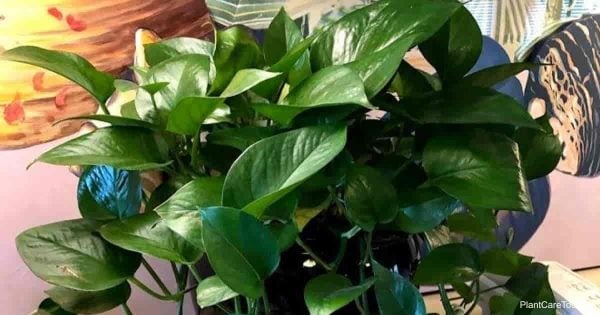Pothos, bearing the scientific name Epipremnum aureum, is an evergreen flowering plant from the Araceae or arum family.
The Epipremnum aureum plant is native to Mo’orea, which is part of the Society Islands in French Polynesia.

But, it has become naturalized in many tropical and sub-tropical forests worldwide, including the West Indies, the Pacific Islands, South Asia, Southeast Asia, and Northern Australia.
Featuring dark green, waxy, heart-shaped leaves splashed with yellow (sometimes with white or cream), the hardy Epipremnum aureum species is primarily grown as a houseplant due to its attractive foliage, hardiness, ability to handle low light and air purifying qualities.
Popular pothos plants have acquired a multitude of common names in different parts of the world.
The most widely used ones include:
- Golden pothos
- Ceylon creeper
- Hunter’s robe
- Silver vine
- Solomon islands ivy
- Ivy arum
- Devil’s ivy
- Devil’s vine
- Taro vine
- Marble Queen
- Money plant
Displaying a climbing growth habit, the plant is best grown in bright indirect light.
However, it also grows well in part sun, if protected from the afternoon sun.
They can tolerate low-light conditions.
For best results, grow pothos plants in a peat-based potting mix and keep it consistently moist during the growing season.
The plant is hardy to the United States hardiness zones 10 to 12.
Epipremnum aureum is often confused with the Philodendron plant.
While both of them are common houseplants, they are separate species.
Related Pothos Reading:
Is Pothos Poisonous or Toxic?
While golden pothos plants make an excellent houseplant, it contains calcium oxalate crystals.
Resembling small shards of glass, the crystals are sharp enough to pierce the skin.
They cannot only physically harm the skin, upon contact, but can damage the mouth and digestive tract, if ingested.
Therefore, the Epipremnum aureum plant needs to be kept away from the reach of children and pets.
The plant is known to be toxic to humans and animals alike.
What Parts Of The Devil’s Ivy Plant Are Poisonous or Toxic?
All parts of the golden pothos plant are toxic and can cause harm upon touch and ingestion.
The crystals of calcium oxalate generally cause localized irritation.
However, in some cases, the ingestion of the pothos plant, in large amounts, can lead to the swelling of the upper airway, which then can cause breathing difficulties.
While the silver vine plant is harmful, it is not known to be fatal in humans.
What Are The Symptoms Of Pothos Plant Poisoning?
In most cases, the insoluble calcium oxalate crystals cause irritation upon coming in contact with the skin and eyes.
However, if ingested, the pothos plant can cause oral irritation, swelling and intense burning sensation in mouth, lips, tongue, and throat vomiting, and in worst cases, difficulty in swallowing and breathing.
Excessive drooling and vomiting are the major signs of pothos plant poisoning in dogs and cats.
Some other signs of Epipremnum aureum poisoning include decreased appetite, oral pain, lethargy, diarrhea, and pets pawing excessively at the mouth.
In rare cases, pothos plant poisoning can cause seizures and unconsciousness.
Severe pothos plant poisoning, caused by ingesting large quantities of the plant, can sometimes lead to renal or liver failure in cats and dogs.
Call animal poison control immediately if you believe your pet has ate some of the toxic plants.
How to Protect Yourself While Handling Pothos Plant
To prevent getting in touch with the calcium oxalate crystals, it is recommended to wear protective gloves while working with these poisonous plants.
Also, be careful to not touch your face, eyes in particular, when working with the plant.
Whether grown as indoors or outdoors, make sure to keep the Epipremnum aureum pothos plant out of the reach of children and pets.
A great way to keep the indoor plants out of reach is to grow them in hanging baskets.
While the skin irritation usually subsides on its own, contact a doctor in case it worsens.
But, in case of accidental ingestion, immediately contact a poison control center.
Some other common houseplants which are poisonous include:
- Peace lily
- Croton – is the Croton poisonous
- Oleander
- Caladium
- Sago palm
- Easter lily
- Dieffenbachia (commonly known as the dumb cane)